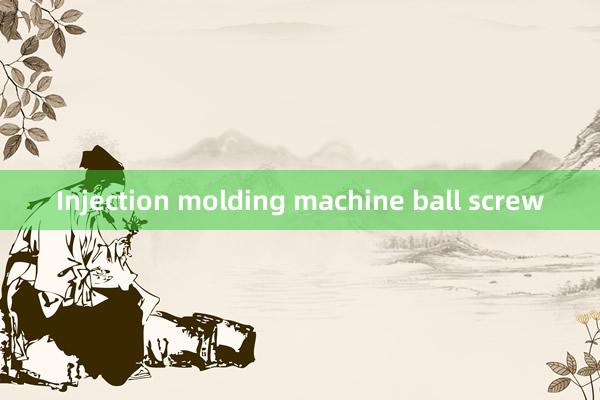
Injection molding machines are an indispensable and important equipment in modern manufacturing and are widely used in the production of plastic products. In injection molding machines, ball screws play a crucial role as a key transmission element. This article will introduce in detail from the structure, working principle, application and maintenance of ball screws.

The basic structure of a ball screw is mainly composed of a screw, a ball, a nut and a guide rail. The lead screw is a long rod with deep threads, the ball is a moving element between the lead screw and the nut, and the nut is a component that rotates along the lead screw and moves in a linear manner. The ball screw is designed to achieve efficient and precise linear motion and can withstand large loads.
In terms of working principle, the ball screw uses rolling friction to reduce friction losses. Compared with conventional sliding lead screws, the ball screw has a smaller coefficient of friction, so it can more effectively convert rotational motion into linear motion. When the motor drives the lead screw to rotate, the ball rolls in the thread groove of the lead screw, causing the nut to move along the lead screw. This process not only improves transmission efficiency, but also achieves higher accuracy, which is suitable for injection molding machines with high requirements for motion accuracy.

In injection molding machines, ball screws are widely used. It is mainly used to control the mold locking and injection actions of the injection molding machine. Mold locking means that during the injection molding process, the mold needs to remain closed before injection to prevent plastic liquid from leaking. The ball screw can quickly and stably complete the locking and unlocking operations of the mold through precise linear motion. The injection action is to inject molten plastic into the mold. The high efficiency and high accuracy of the ball screw ensure the uniformity and accuracy of the injection, thereby improving the quality of the finished product.

In addition to playing a role in the core functions of the injection molding machine, the advantages of the ball screw are also reflected in its long service life and low maintenance costs. Due to the small friction loss of the ball screw and the relatively low wear degree, it can maintain a good working condition after long-term use. The ball screw has a relatively simple structure and is easy to maintain and replace, reducing the risk of equipment shutdown during production.
Although ball screws have many advantages, some issues need to be paid attention to during use. It is crucial to ensure that the ball screw is well lubricated. Proper lubrication can reduce wear and improve service life. Generally speaking, it is recommended to check the lubrication status regularly and refuel according to actual needs. Avoid excessive impact or load from the ball screw to avoid damage. When using the injection molding machine, operators should follow the equipment usage specifications to avoid overload operation.
In order to further improve the efficiency of ball screws, many manufacturers are still conducting technological innovation. For example, the wear resistance and load bearing capacity of the ball are improved by improving the material and surface treatment process. With the development of automation technology, the application of intelligent monitoring systems has gradually become popular. These systems can monitor the working status of the ball screw in real time, detect potential problems in a timely manner, and reduce the occurrence of faults.
Generally speaking, ball screws play an important role in injection molding machines, and their efficient and precise motion characteristics enable injection molding machines to complete complex production tasks. By understanding the structure and working principle of ball screws, we can better grasp the use and maintenance of injection molding machines, thereby improving production efficiency and reducing costs. In the future, with the continuous advancement of technology, the application fields of ball screws will be more extensive, and their performance will continue to improve, providing stronger support for the development of manufacturing.